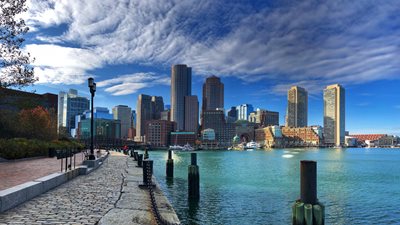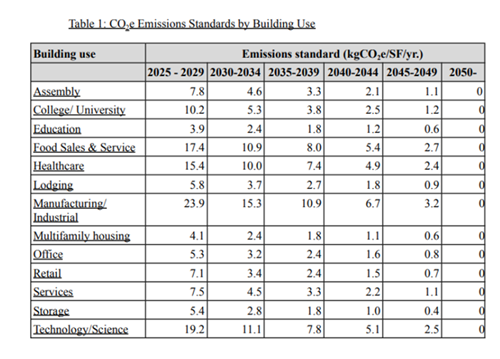Article Index
- What is the Building Emissions Reduction and Disclosure Ordinance (BERDO)?
- Boston BERDO 2.0 Requirements
- Carbon Emission Reduction Requirements
- What are the Risks for Not Complying?
- What Do I Have to Do as a Trustee?
- About FirstService Energy
- Connect With Us!
Delivering Value: Learn more about FirstService Residential's Energy Aggregation Purchasing Program
The BERDO Boston ordinance has been to enhance carbon emissions reduction in the city. The Building Emissions Reduction and Disclosure Ordinance (BERDO) 2.0 sets requirements for large buildings to reduce their energy and water use data. The goal is to reduce their emissions gradually to net zero by 2050.
What is the Building Emissions Reduction and Disclosure Ordinance (BERDO)?
In May 2013, the Council passed CBC Chapter VII, Section 7-2.2 Building Energy Reporting and Disclosure Ordinance (BERDO) proposed by Mayor Thomas M. Menino.
BERDO requires that all commercial and residential buildings that are 35,000 square feet or have 35 units or more report their energy and water use to the City of Boston every year.
The purpose of the ordinance was to reduce emissions including greenhouse gases from energy production, encourage efficient use of energy and water, and develop investment in a green economy by requiring the reporting and disclosure of annual energy and water use in all large buildings. The ordinance was updated on May 14, 2014 by former Mayor Walsh with an amendment to extend the reporting deadline from May 15 to September 15, 2014.
Docket #0775, Ordinance Amending City of Boston Code, Ordinances, Chapter VII, Sections 7-2.1 and 7-2.2, Building Energy Reporting and Disclosure (BERDO), sponsored by Council President Pro Tempore O’Malley, which he affectionately refers to as BERDO 2.0, sets emissions targets and reporting requirements for buildings greater than or equal to 20,000 square feet, establishes the Emissions Review Board with community representation to increase accountability and transparency, and establishes an environmental justice Buildings Emissions Investment Fund. The ordinance also includes performance standards for large buildings to decrease carbon targets with flexibility to assist companies in complying.
The Council voted unanimously to pass the ordinance.
In the fall of 2021, the City of Boston adopted the second iteration of the Building Energy Reporting and Disclosure Ordinance (“BERDO 2.0”) (Docket #0775, Ordinance Amending City of Boston Code, Ordinances, Chapter VII, Sections 7-2.1 and 7-2.2).
BERDO 2.0 sets emissions targets and reporting requirements for buildings greater than or equal to 20,000 GSF; establishes an Emissions Review Board with community representation to increase accountability and transparency; and establishes an environmental justice Buildings Emissions Investment Fund. The ordinance also includes performance standards for large buildings to decrease carbon targets with flexibility to assist companies in complying.
BERDO 2.0 is likely to have a significant impact on existing buildings in the future. Project teams planning new buildings should consider the future implications of BERDO 2.0 in addition to current building code requirements.
Boston BERDO 2.0 Requirements

Buildings Impacted
BERDO applies to the following buildings:
-
Non-residential buildings that are 20,000 square feet or larger.
-
Residential buildings that have 15 or more units.
-
Any parcel with multiple buildings that sum to at least 20,000 square feet or 15 units.
-
2022 BERDO COVERED BUILDINGS LIST
Buildings between 20,000 and 35,000 square feet or residential buildings with 15 to 35 units will need to begin reporting their energy use in 2022. They will not be subject to the emissions standards until 2031, reporting for 2030 emissions.
Reporting Requirements
BERDO 2.0 requires buildings over 20,000 GSF to annually report on emissions by May 15th of each year. Specific information required to be reported includes:
-
Energy and Use, used to calculate CO2e emissions
-
Primary Building Use
-
Any Renewable Energy Certificates (RECs) purchased
-
Any Power Purchase Agreements (PPAs) covering building
-
If unique emission factors were used
-
Contact information for building ownership/management
Reporting would typically be done through Energy Star Portfolio Manager.
Failure to comply with reporting results in a fine of $300/day for buildings over 35,000 GSF, and $150 per day for projects between 20,000 and 35,000 GSF.
Consideration of BERDO 2.0 will be important for projects going forward. Our analysis of recent projects shows that new projects designed to current energy code will likely be in compliance with 2025 requirements. Beyond that date, fully electrified projects are likely to stay in compliance, as emission factors for electricity should reduce at roughly the same rate that the grid does.
Carbon Emission Reduction Requirements

Beginning 2025, buildings over 35,000 GSF must have emissions less than or equal to the limits in Table 1 (below). Buildings between 20,000 and 35,000 GSF will have to comply beginning in 2030.
Emissions Factors will be set by a Review Board. EV charging and Emergency Power are excluded.

Source: greenengineer.com
Projects may use PPAs, Municipal Aggregation, or RECs to lower their emissions. For PPAs, the RECs must be retired. For RECs, they must be current NEPOOL, RPS Class I.
Projects that fail to comply can make alternative compliance payments. The initial cost of an Alternative Compliance Payment shall be $234 per metric ton of CO2e.
Projects that do not comply, and do not make alternative compliance payments will be subject to fines. Buildings over 35,000 GSF will be fined $1000/day, and buildings between 20,000 to 35,000 GSF will be fined $300/day.
What are the Risks for Not Complying?
In accordance with BERDO 2.0., Massachusetts trustees need to create a plan to reduce carbon emissions according to the set limits. You can consult with FirstService Residential Energy on how to create a carbon reduction roadmap to stay ahead of the curve when it comes to reducing carbon emissions.
Moving forward, it’s best practice that all capital projects should be observed through the lens of carbon reduction. For example, if you as a trustee are replacing a piece of equipment, is there an alternative that provides a less carbon-intensive option?
The new ordinance has set a strict timeline that requires all affected buildings to meet a series of emissions targets starting in 2025 that result in them being carbon neutral by 2050. These targets are set at five-year intervals and according to building type to make sure decarbonization projects stay on track. Building owners will do their part by submitting an emission reduction plan that outlines how their property will meet its targets. For instance, owners can achieve carbon neutrality by making energy efficiency improvements, switching from gas to electric heating, and incorporating clean energy systems like solar.
What Do I Have to Do as a Trustee?
In accordance with BERDO 2.0., Massachusetts trustees need to create a plan to reduce carbon emissions according to the set limits. You can consult with FirstService Energy on how to create a carbon reduction roadmap to stay ahead of the curve when it comes to reducing carbon emissions.
Moving forward, it’s best practice that all capital projects should be observed through the lens of carbon reduction. For example, if you as a trustee are replacing a piece of equipment, is there an alternative that provides a less carbon-intensive option?
The new ordinance has set a strict timeline that requires all affected buildings to meet a series of emissions targets starting in 2025 that result in them being carbon neutral by 2050. These targets are set at five-year intervals and according to building type to make sure decarbonization projects stay on track. Trustees will do their part by submitting an emission reduction plan that outlines how their property will meet its targets. For instance, owners can achieve carbon neutrality by making energy efficiency improvements, switching from gas to electric heating, and incorporating clean energy systems like solar.
About FirstService Energy
FirstService Energy is the energy management and advisory affiliate of FirstService Residential, the largest manager of residential communities in North America. Our energy experts help our clients significantly enhance their building’s energy efficiency by developing strategies to reduce energy costs, consumption, and emissions. FirstService Energy considers all practical efficiency opportunities and provides solutions tailored to each property’s energy management needs.
With our unique approach to energy management through the application of state-of-the-art data analysis, we are able to evaluate a property’s energy consumption. We then customize cost-effective solutions that reduce energy expenses, boost efficiency, and shrink environmental impact. Since 2009, we have worked to save FirstService Residential properties more than $23 million while reducing their carbon footprint by 16%.
Connect With Us!
FirstService Energy has established itself as the trusted energy advisor to properties managed by FirstService Residential by recommending ways to improve energy efficiency while reducing operating costs and carbon emissions. As a FirstService Residential affiliate, our combined resources and capabilities enable us to offer exclusive, value-add programs that positively impact your property’s bottom line.
Whether it is a question, a problem, or a new business opportunity, you will want to partner with a company like FirstService Residential that has a proven history of support and knows best practices for your industry.